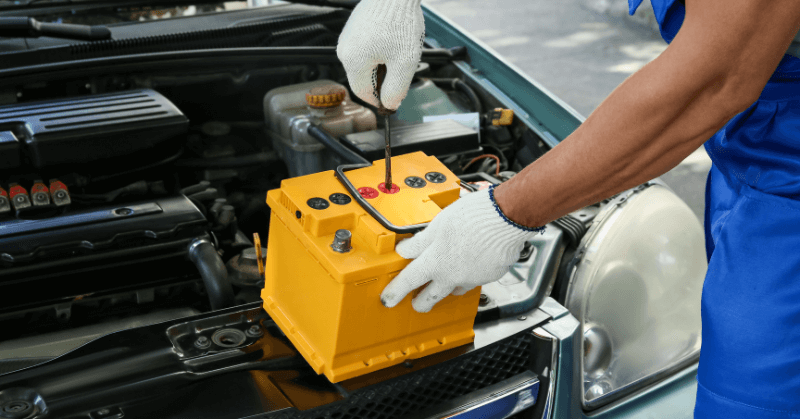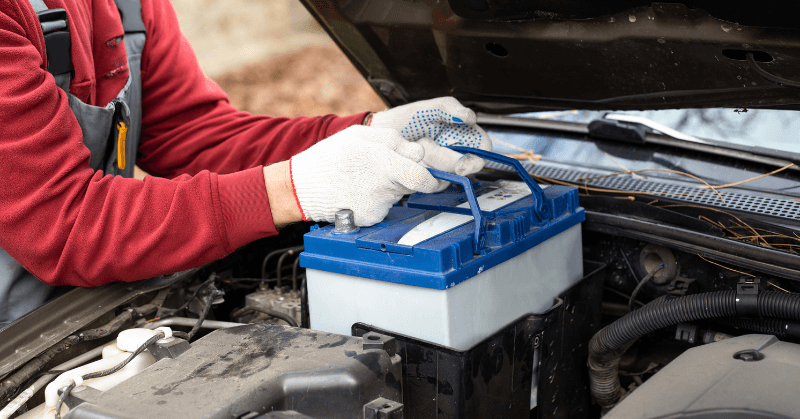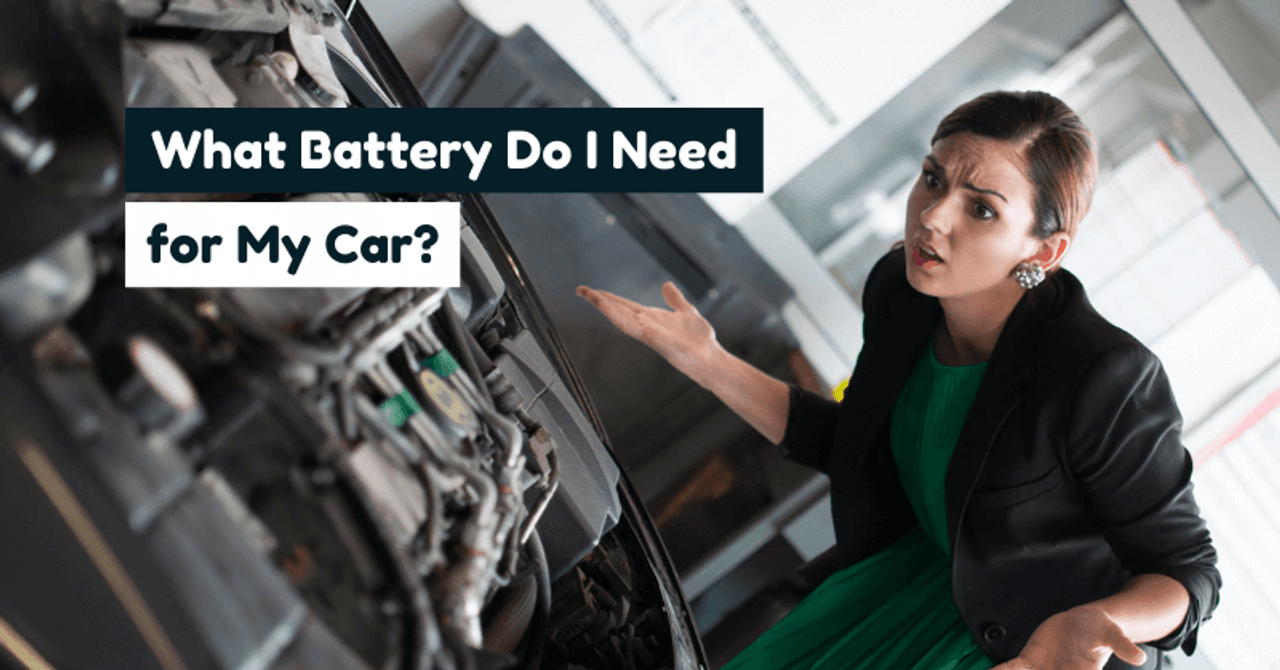What Battery for My Car? A Guide for How to Choose a Car Battery
Every car battery comes with a specific lifespan during which it perfectly powers up your vehicle's traction motor and all other electronic equipment. Once the lifespan completes, the performance of a car battery falls below 80% of its total capacity.
Being a car owner, you must be familiar with the symptoms that show your battery is dying, such as a bulging case and a smell coming out of the battery. If you observe these signs, it is time to say goodbye to your old battery and buy a new one for your vehicle. But the question that may come to your mind is, “What battery for my car?”
If you are searching for “what battery do I need for my car,” you are in the right place. This article explains how to choose the right battery for your vehicle and presents key things to consider while selecting the car battery.
What is a car battery?
A rechargeable device that provides an electric vehicle with enough torque to rotate its traction motor and powers up other electronic components within the car, such as headlights, music player, mobile charger, is known as a car battery.
A number of car batteries are available in the market, including lead-acid, nickel-cadmium, lithium-ion, and nickel-metal hybrid. Out of them all, lithium-ion batteries are generally considered the best choice to power up electric vehicles.

The battery is a key component of an electric car. Let's understand how it operates and provides you with enough power to run a car. While starting your car, you press the starter button or an ignition switch. This is where you insert your car key.
Pressing the ignition switch sends a small amount of electric current to a starter relay and a pair of contacts get closed. Then, a car battery sends the desired voltage to a starter motor and starts your car.
AGM and flooded batteries are most commonly used in electric vehicles. They both use lead-acid technology. The lead-acid plates inside the battery are immersed in a solution of two-third water and one-third sulfuric acid. This solution is called an electrolyte.
When you turn on the ignition switch, the active lead material on the plates will react with the acid in the solution. As a result, a bigger electric current is generated. This current passes through the starting system and starts your car with a chain of reactions.
How can you choose a good car battery?
Are you searching for “what battery does my car need?” This section explains it all with a step-by-step guide. Let's look at them one by one.
Step 1: Find the correct battery size
Car owners often ask, “What size battery do I need?” Considering you have the same question in mind, here is a detailed answer to the query.
One thing you should keep in mind is that one size battery can't fit in all cars. It is a fact that a truck or a big V8 always needs a bigger and better battery than your standard small car. Therefore, the battery size varies from one vehicle to another, depending on its brand and model.
Group size 24/24F (top terminal) is commonly seen in Toyota, Lexus, Nissan, Honda, Acura, and Infiniti. Similarly, group size 35 (top terminal) is often seen in Subaru, Honda, Toyota, and Nissan.
If you fail to choose the right battery type and size, it will not be able to provide the car with enough efficiency. In addition, the lifespan of the battery may become shorter. Let's look at what battery size is perfect for your car.
Does car battery size really matter?
Yes, it matters a lot, as stated earlier. For example, bigger lead-acid batteries offer greater performance than a one in smaller size. Similarly, if you choose a large battery size, it will have greater reserve capacity and more cold cranking amps. In comparison, small batteries are used in less driving conditions and less demanding cars.
However, modern technology has changed this concept. You can easily find lightweight batteries with adequate CCA rating. But these batteries are more expensive than others. If you don't have a budget issue, you can prefer buying a lightweight battery design with higher power rating and extended lifespan.
Step 2: Find the minimum cold cranking amps (CCA) for your car
The ability of a battery to start the engine in cold temperature is commonly called Cold Cranking Amps (CCA). The battery industry uses this rating to determine how worthy a battery is to start a car in a cold environment. The reason why this rating is considered important is that it is more difficult to start an engine in a cold environment than in a hot temperature.
The CCA rating shows the number of amps a 12V battery can provide at 0°F for half a minute (30 seconds), thereby maintaining at least 7.2V. The higher CCA rating indicates that the battery has a greater starting power.
Determining the CCA rating
You can find the minimum CCA requirement in the owner's manual. In case you don't have a manual, you can find it on the battery label. It usually ranges between 100 and 850 or higher. It largely depends on your car type.
Different cars need different power to start the engine in cold weather. The reason why considering starting an engine in cold weather is important is that the cold temperature slows down the reactions that occur inside the battery.
The CCA value must meet the minimum rating your car manufacturer has recommended. It will allow your car to function properly. The minimum CCA rating for high-performance cars is somewhere close to 500. In comparison, 150 is the minimum CCA rating for smaller cars.
It is always better that you choose a battery with a CCA rating more than the minimum recommended value, but never use a battery with a CCA rating lower than the minimum value.
If you reside in a cold area, CCA is the most important thing you should keep in mind when replacing your car battery. The three best ways to find CCA ratings are as follows.
- Check the battery label.
- Find it out in the owner's manual.
- Search it online (provided by the manufacturer).
Step 3: Determine the type of battery required
Let's first explore different car batteries before we choose the one for our car.
- Thin plate pure lead AGM battery: It is an ideal choice for truck and car enthusiasts. This battery offers the highest CCA value and performs extremely well in extreme atmospheric conditions. 99.9% pure lead is used in the manufacturing, which is why it provides fastest charging.
- AGM battery: It works perfectly in both extreme cold and extreme hot environments. This battery offers a higher CCA rating and is commonly used in new cars. If you have a lot of electronic accessories in your car, this battery is a perfect fit. An AMG battery is maintenance free.
- Flooded battery: It is mostly used in trucks and cars, but offers a low CCA rating. This battery struggles to start a car in extreme cold and hot environments. It does not work well if the car has a lot of electronic accessories. It requires a significant amount of maintenance.
Now that you have seen different batteries that are used in cars. Let's understand which one to consider while replacing your car battery.
If your car has a flooded battery installed on it, it will be better to upgrade and choose an AGM battery this time. In case your car already has an AGM battery installed, it is better to replace it with an AGM battery because wet batteries often overheat.
An AGM battery is much better to deal with extreme cold and hot environments. Therefore, if you live in extreme weather conditions, choosing this battery will be worth it for sure.
Step 4: Select your new battery
Now that you know how to correct battery size, the minimum CCA rating, and the type of battery you need for your car. It is time to choose the right battery and install it right away.
Many people install a car battery on their own. If you can lift it up and place it in the car comfortably, you can easily install it by yourself. If you are looking forward to buying a reliable battery for your car, find out the batteries collection at Renogy.
When should you replace your battery?
The average life of a car battery lies between 3 and 5 years. If your battery is older than the mentioned period, it is time to buy a new one and install it on priority to ensure all electronic components of your car perform well.
If you notice an unpleasant smell coming out of the car battery, it means that it has failed to perform what it was supposed to do. Similarly, if the battery case is bulged, it is another symptom that your battery’s performance is degraded greatly.
Moreover, if your car headlights are dimming day by day, it shows that the battery has failed to provide the lights with enough voltage and power. In all these conditions, all you need to do is replace the old battery with a new one.
If you want to learn how to replace a car battery and more useful information, explore more for guide Car battery replacement.

Factors to consider when choosing a car battery
If you are planning to buy a new car battery, make sure to consider the factors listed below.
- Battery size: Check the dimensions of the battery installed in your car and make a new purchase accordingly.
- Make: You will never want to purchase a battery manufactured last year. This is why it is important to check if the battery is fresh (made hardly a few months ago).
- Capacity: A good battery should have high power and high storage capacity.
- Maintenance: The batteries that need maintenance require servicing once in 6 months. In comparison, sealed batteries do not require maintenance. It is better to choose a maintenance-free battery for your car.
- Warranty: Try choosing a battery with a longer warranty. It will help you get free repair or service if any issue arises.
Conclusion
“What battery does my car need” is one of the frequently asked questions by car owners. If you are searching for the same, remember to keep a few things in mind when buying a new car battery, e.g., the battery size, the minimum cold cranking amps rating, and the battery type. To know how you can find these things, read the discussion above.
As far as the battery types are concerned, flooded batteries offer low CCA rating and high maintenance effort, whereas AGM type batteries need no maintenance and offer higher CCA values. Looking at this factor, replacing your standard flooded battery with an AGM battery will be a good option. If you want to explore a wide collection of long-lasting car batteries, visit Renogy.
FAQs
How do I know what battery my car needs?
You need to find the right battery size, the minimum CCA rating of your car, and the type of battery you prefer (flooded, AGM, or gel). Once done, it is the one you need for your car.
How long do car batteries last?
The average lifespan of car batteries is somewhere between 3 and 5 years. Taking good care of your battery, parking your car in shady areas, and conducting routine checkups can enhance the battery’s lifespan. Weather has the biggest negative impact on the performance of a car battery.
Can I replace my car battery myself?
Yes, replacing the battery on your own is something you can easily do, as long as you can lift it up comfortably while removing it from the car. One thing you must keep in mind when replacing your car battery is to ensure both positive and negative terminals are appropriately connected.
What's the average cost of a car battery in the USA?
The cost of a car battery may vary depending on different factors, such as make, model, and size. If we talk about the battery prices in the United States, buying a standard flooded car battery will cost you between $185 and $300. In comparison, the cost of replacing a premium AGM battery is between $250 and $400.
Are more expensive car batteries worth it?
Yes, they may be worth it. More expensive car batteries come with a longer warranty and enhanced lifespan compared to traditional batteries. In addition, they are usually much more reliable than cheaper batteries.











